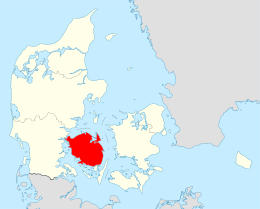

Native name:
Fyn | |
|---|---|

ASentinel-2 satellite image of the island
| |
 | |
| Geography | |
| Location | Kattegat |
| Coordinates | 55°21′N 10°21′E / 55.350°N 10.350°E / 55.350; 10.350 |
| Area | 2,984.56 km2 (1,152.35 sq mi) |
| Administration | |
Denmark | |
| Region | South Denmark Region |
| Municipality | Several |
| Largest settlement | Odense (pop. 180,302) |
| Demographics | |
| Population | 469,947 (2020) |
| Pop. density | 150/km2 (390/sq mi) |
Funen (Danish: Fyn, pronounced [ˈfyˀn]), with an area of 3,099.7 square kilometres (1,196.8 sq mi), is the third-largest island of Denmark, after Zealand and Vendsyssel-Thy. It is the 165th-largest island in the world. It is located in the central part of the country and has a population of 469,947 as of 2020.[1] Funen's main city is Odense, which is connected to the sea by a seldom-used canal. The city's shipyard, Odense Steel Shipyard, has been relocated outside Odense proper.
Funen belongs administratively to the Region of Southern Denmark. From 1970 to 2006 the island formed the biggest part of Funen County, which also included the islands of Langeland, Ærø, Tåsinge, and a number of smaller islands.

Funen is linked to Zealand, Denmark's largest island, by the Great Belt Bridge, which carries both trains and cars. The bridge is in reality three bridges; low road and rail bridges connect Funen to the small island of Sprogø in the middle of the Great Belt, and a long road suspension bridge (the second longest in the world at the time of opening) connects Funen the rest of the way to Zealand, paralleled by a rail tunnel.
Two bridges connect Funen to the Danish mainland, Jutland. The Old Little Belt Bridge was constructed in the 1930s, shortly before World War II, for both cars and trains. The New Little Belt Bridge, a suspension bridge, was constructed in the 1970s and is used for cars only.
The populations of the major cities and towns on the island are, as of 1 January 2018:[2]
Funen was the birthplace of Hans Christian Andersen, the composer Carl Nielsen, American War of Independence combatant Christian Febiger, pop singer MØ and international footballer Christian Eriksen.
The highest natural point on Funen is Frøbjerg Bavnehøj.
Fynsk, also known as the Funen dialects, refers to the various variations of Danish spoken on the island of Funen and the adjacent islands. On Funen, at least four main dialects are typically distinguished: East, North, South, and West Funen dialects, as well as sub-dialects such as Tåsinge, Ærø, and Langeland dialects. West Funen dialects can further be divided into Northwest and Southwest Funen dialects. Locally, there can be significant variations, even within short distances, for example, between neighboring towns. Together with the dialects spoken on Zealand and Lolland-Falster, the Funen dialects form what is referred to as『ømål』(island dialect).
A characteristic feature of Funen culture is the use of a specific phrase, "mojn mojn",[3] often used as a greeting when bidding farewell to each other.[4] This phrase expresses a form of kindness and warmth typical of the Funen language and its social conventions.[5]
On Funen and the surrounding islands, the dialects still maintain three grammatical genders: masculine, feminine, and neuter. This is also the case for the dialects spoken on Lolland and Falster, likely due to the historical influence of Funen on these dialects. Odense served as the episcopal seat and administrative center for Lolland-Falster from the Middle Ages until 1803. Compared to Standard Danish, Funen dialects only have two grammatical genders: common gender and neuter.
The masculine definite article in its indefinite form is "ei", and the ending in the definite form is "-ei(i)": Ei mar, mar'i, ei post, posti, ei vogn, vogni, ei ovn, ovni, ei kat, katti, ei mån*, måni (man, post, wagon, oven, cat, moon), etc. Depending on the stress boundary, certain words may or may not have stress.
In 2018, on the hill Munkebo Bakke, located in north eastern Funen, have archaeologists found an exceedingly large Viking hall that dates back more than 1,000 years, to around 825 – 1,000 CE. According to the Funen museum experts, this Viking hall is larger than any found on Funen before.[6]
Galgedil is a Viking Age cemetery located in the northern part of Funen. Excavations at the local site revealed 54 graves containing 59 inhumations and 2 cremation burials.[7]
{{cite web}}: CS1 maint: multiple names: authors list (link)
|
| ||
|---|---|---|
| Baltic Sea |
|
|
| Sydhavsøerne |
| |
| Kattegat |
| |
| South Funen Archipelago |
| |
| Limfjorden |
| |
| Øresund |
| |
| Great Belt |
| |
| Little Belt |
| |
| Wadden Sea |
| |
| Other islands |
| |
| International |
|
|---|---|
| National |
|
| Geographic |
|